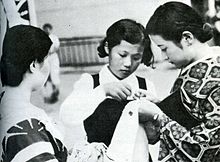Senninbari
A Senninbari ( Japanese 千人 針 , German roughly "stitches of 1000 people") is a cloth that was made as a talisman by Japanese women when their husbands had to go to war. The cloth, which is about one to one and a half meters long and about 15 cm wide, was embroidered with good luck motifs consisting of 1000 stitches. Sometimes coins were also sewn on, so that one can also speak of the function of an amulet . As such, it is part of Shinto culture, especially during the Japanese Empire .
overview
In addition to brightly colored, single-colored cloths, mostly white fabrics were used for a Senninbari, and mostly red thread for the stitches . The Japanese flag , a tiger or patriotic slogans were often embroidered. One of the most famous sayings was: 武 運 長久 ( buun chōkyū , "fortune in war forever"). Usually the senninbari was tied around the waist. Such senninbari were approx. 15 cm wide and approx. 75 to 90 cm long. In addition, the Senninbari was also used as a hachimaki , undershirt or belt.
The first Senninbari were made during the First Sino-Japanese War . Traditionally, mothers, wives, or sisters made a senninbari by standing in a crowded place, such as a train station, and asking women passing by to add a stitch as a French knot. In addition, patriotic women's associations such as the Aikoku Fujinkai ( 愛国 婦人 会 ) or the Kokubō Fujinkai ( 国防 婦人 会 ) also organized meetings that served specifically for the joint production of Senninbari. The Senninbari were then sent as so-called Imonbukuro ( 慰問 袋 , for example: "Love gift package; shipment from home"). It was common practice for women born in the year of the tiger to add a certain number of additional stitches (commonly either 12 stitches or a number of stitches appropriate to their age).
Senninbari can be seen in Clint Eastwood's film Letters from Iwo Jima .
See also
Individual evidence
- ↑ Needleprint - Stitches of a 1,000 Women
- ↑ 千人 針 ( Memento of the original from August 10, 2009 in the Internet Archive ) Info: The archive link was inserted automatically and has not yet been checked. Please check the original and archive link according to the instructions and then remove this notice.
Web links
- Nambu World: Senninbari (English)
- Senninbari - painting by Henry Sugimoto, 1942
- Senninbari (Japanese) - essay by the Japanese physicist and essayist Terada Torahiko at Aozora
